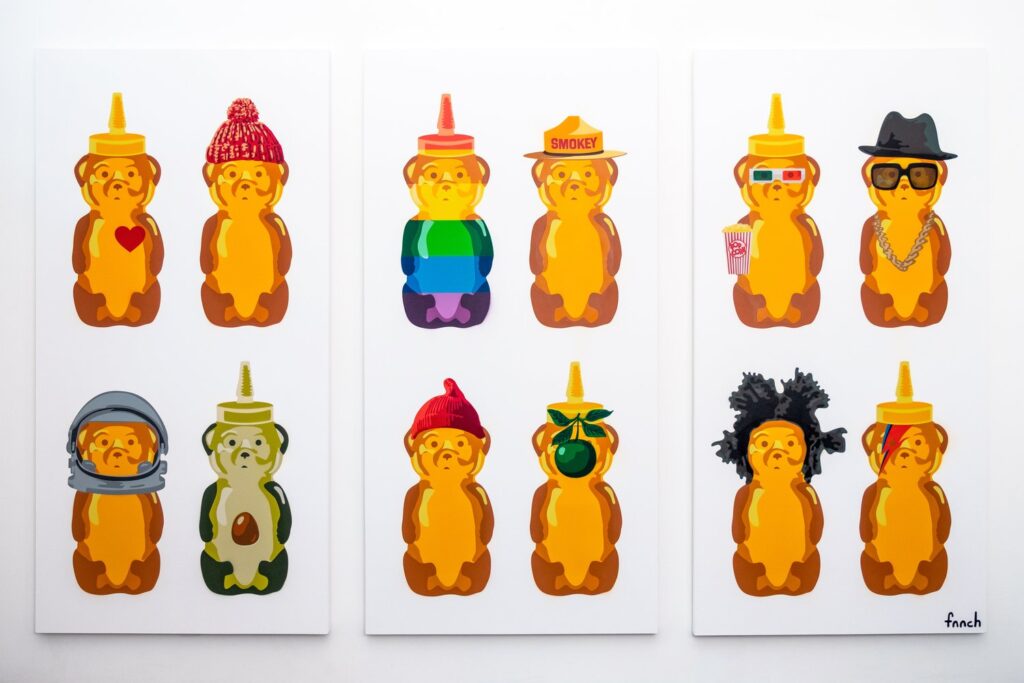Street art has long been an urban hallmark—a way for artists to leave their mark in public spaces, weaving a colorful thread into the city’s visual and cultural fabric. For one Kirkwood native, that expression came to life in the form of honey bears. These charming, nostalgic figures—iconic in their association with grocery store shelves—have become a canvas for creativity, and now, they’re making their way from the streets to the renowned City Museum in St. Louis.
The Artist Behind the Bears
Meet Ben Stanton, a Kirkwood native and the creative force behind the Honey Bear movement in St. Louis. Stanton’s art career began as a personal exploration of his environment, often experimenting with different forms of expression, from graffiti tags to stencil work. However, it wasn’t until he stumbled upon a forgotten honey bear bottle in his kitchen that inspiration struck.
“I was cleaning out a cabinet when I found this old honey bear bottle,” Stanton recalls. “It had so much character—this quirky, innocent charm. I thought, what if this became more than just a bottle? What if it was a canvas?”
What started as a small experiment soon grew into something much larger. Stanton began painting honey bears with vivid designs and leaving them around Kirkwood. Each bear told its own story, featuring everything from bright geometric patterns to messages of social justice. Within months, Stanton’s work started to gain traction on social media, with locals posting photos and mapping out where the bears could be found.
The Rise of the Honey Bears
Street art often blurs the lines between public space and personal expression, and Stanton’s honey bears were no exception. For him, they were more than just a creative outlet—they were a way to connect with the community.
“People would see a bear and smile,” Stanton says. “I think there’s something universally relatable about them. It’s a bit of nostalgia but also a bit of whimsy.”
The honey bears became something of a scavenger hunt for residents, who eagerly sought out Stanton’s newest creations. Each bear became a symbol of surprise and delight, often appearing in unexpected places like park benches, alleyways, and even tucked into tree branches. Stanton also began collaborating with local businesses, creating custom bears for shop windows and murals.
The City Museum Flow
In 2024, Stanton’s honey bears caught the attention of the City Museum in St. Louis, a venue known for celebrating eclectic and interactive art. With its labyrinthine architecture and emphasis on creativity, the museum seemed like the perfect place for Stanton’s work to thrive.
“City Museum has always been about exploration and play,” says Sarah Levine, the museum’s artistic director. “When we saw Ben’s honey bears, we knew they’d be a fantastic fit. They bring that same sense of joy and curiosity.”
The connect, titled Hankering for Honey Bears, is part of a larger exhibit focusing on modern street art and its integration into urban culture. Stanton was tasked with creating an immersive experience, blending his signature bears with the museum’s unique spaces.
Creating the Exhibit
For Hankering for Honey Bears, Stanton wanted to go beyond static displays. The exhibit features interactive installations, including a “Honey Bear Forest” where visitors can walk through towering sculptures of the bears, each hand-painted with vibrant designs. Another highlight is the “Honey Bear Hive,” a glowing room filled with suspended bears that light up in response to sound.
“I wanted people to feel like they were stepping into a world where these bears came to life,” Stanton explains. “It’s about creating an experience that’s both playful and immersive.”
The exhibit also includes a workshop space where visitors can design their own honey bear-inspired art. Stanton leads occasional sessions, teaching participants how to transform everyday objects into creative works.
The Intersection of Street Art and Fine Art
One of the most intriguing aspects of Stanton’s work is its ability to straddle the line between street art and fine art. While his honey bears originated as guerrilla-style installations, their transition into a museum setting has opened up new conversations about the value and perception of public art.
“Street art is often seen as temporary or subversive,” Stanton says. “But I think there’s a growing recognition that it can be just as meaningful and impactful as anything you’d see in a gallery.”
This shift is particularly evident in Stanton’s use of the honey bear, a universally recognizable object that transcends barriers of age, culture, and class. By elevating something so ordinary, Stanton invites viewers to rethink the role of art in their daily lives.
Community Pressure
Beyond the museum walls, Stanton’s honey bears have continued to foster a sense of community in St. Louis. He frequently collaborates with local organizations, using his art to support causes like environmental conservation, mental health awareness, and education.
One recent project involved creating a series of bears for a local food bank, each one decorated with messages about combating hunger. Proceeds from the project helped fund meals for families in need.
“Art has the power to bring people together,” Stanton says. “Whether it’s on the street or in a museum, it’s about creating connections and sparking conversations.”
The Future of the Honey Bears
As Stanton’s honey bears gain recognition, he shows no signs of slowing down. He’s currently working on expanding the project to other cities, with plans for a traveling exhibit that will bring the bears to urban centers across the country.
“I want the honey bears to be everywhere,” Stanton says. “It’s not just about the art—it’s about the joy they bring. If someone sees a bear and it makes their day a little brighter, then I’ve done my job.”
Impression
From the streets of Kirkwood to the halls of the City Museum, Ben Stanton’s honey bears have captured the hearts of St. Louis residents and beyond. Their charm lies not only in their design but in their ability to evoke a sense of wonder and nostalgia. As Hankering for Honey Bears opens its doors, it offers a chance to celebrate the intersection of art, community, and creativity—one bear at a time.
Whether you’re a longtime fan or new to Stanton’s work, the exhibit promises to be a feast for the senses. So, next time you’re wandering the streets of St. Louis or exploring the City Museum, keep an eye out—you never know where a honey bear might be hiding.
No comments yet.








